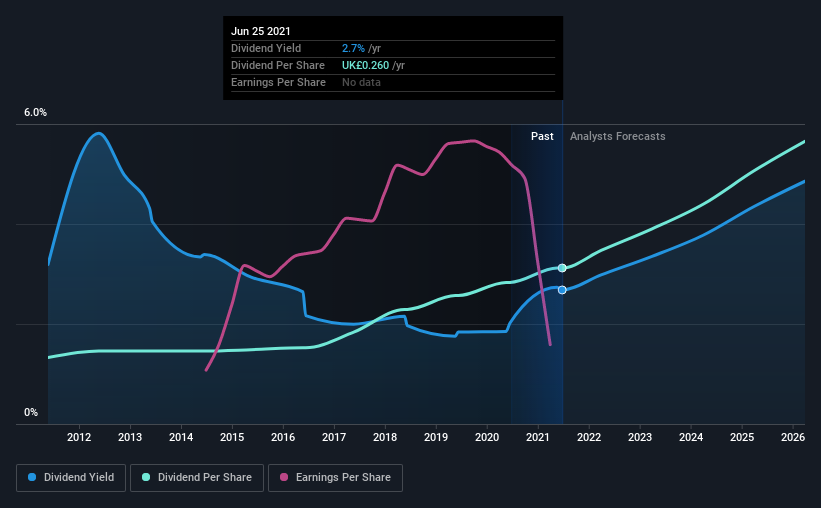Don't Race Out To Buy HomeServe plc (LON:HSV) Just Because It's Going Ex-Dividend
HomeServe plc (LON:HSV) is about to trade ex-dividend in the next 3 days. The ex-dividend date is one business day before the record date, which is the cut-off date for shareholders to be present on the company's books to be eligible for a dividend payment. It is important to be aware of the ex-dividend date because any trade on the stock needs to have been settled on or before the record date. In other words, investors can purchase HomeServe's shares before the 1st of July in order to be eligible for the dividend, which will be paid on the 2nd of August.
The company's next dividend payment will be UK£0.20 per share, on the back of last year when the company paid a total of UK£0.26 to shareholders. Looking at the last 12 months of distributions, HomeServe has a trailing yield of approximately 2.7% on its current stock price of £9.7. If you buy this business for its dividend, you should have an idea of whether HomeServe's dividend is reliable and sustainable. As a result, readers should always check whether HomeServe has been able to grow its dividends, or if the dividend might be cut.
Check out our latest analysis for HomeServe
Dividends are typically paid from company earnings. If a company pays more in dividends than it earned in profit, then the dividend could be unsustainable. An unusually high payout ratio of 281% of its profit suggests something is happening other than the usual distribution of profits to shareholders. Yet cash flow is typically more important than profit for assessing dividend sustainability, so we should always check if the company generated enough cash to afford its dividend. It paid out more than half (53%) of its free cash flow in the past year, which is within an average range for most companies.
It's good to see that while HomeServe's dividends were not covered by profits, at least they are affordable from a cash perspective. Still, if the company repeatedly paid a dividend greater than its profits, we'd be concerned. Extraordinarily few companies are capable of persistently paying a dividend that is greater than their profits.
Click here to see the company's payout ratio, plus analyst estimates of its future dividends.
Have Earnings And Dividends Been Growing?
Companies with falling earnings are riskier for dividend shareholders. If earnings decline and the company is forced to cut its dividend, investors could watch the value of their investment go up in smoke. With that in mind, we're discomforted by HomeServe's 14% per annum decline in earnings in the past five years. Such a sharp decline casts doubt on the future sustainability of the dividend.
Another key way to measure a company's dividend prospects is by measuring its historical rate of dividend growth. In the past 10 years, HomeServe has increased its dividend at approximately 8.9% a year on average. That's intriguing, but the combination of growing dividends despite declining earnings can typically only be achieved by paying out a larger percentage of profits. HomeServe is already paying out a high percentage of its income, so without earnings growth, we're doubtful of whether this dividend will grow much in the future.
Final Takeaway
Has HomeServe got what it takes to maintain its dividend payments? It's never fun to see a company's earnings per share in retreat. What's more, HomeServe is paying out a majority of its earnings and over half its free cash flow. It's hard to say if the business has the financial resources and time to turn things around without cutting the dividend. With the way things are shaping up from a dividend perspective, we'd be inclined to steer clear of HomeServe.
Although, if you're still interested in HomeServe and want to know more, you'll find it very useful to know what risks this stock faces. For example, we've found 4 warning signs for HomeServe that we recommend you consider before investing in the business.
We wouldn't recommend just buying the first dividend stock you see, though. Here's a list of interesting dividend stocks with a greater than 2% yield and an upcoming dividend.
This article by Simply Wall St is general in nature. It does not constitute a recommendation to buy or sell any stock, and does not take account of your objectives, or your financial situation. We aim to bring you long-term focused analysis driven by fundamental data. Note that our analysis may not factor in the latest price-sensitive company announcements or qualitative material. Simply Wall St has no position in any stocks mentioned.
Have feedback on this article? Concerned about the content? Get in touch with us directly. Alternatively, email editorial-team (at) simplywallst.com.

 Yahoo Finance
Yahoo Finance 
